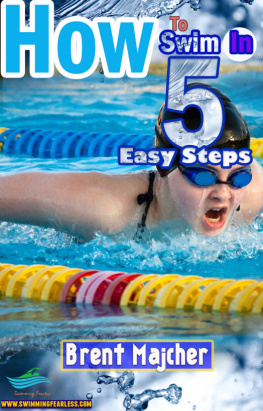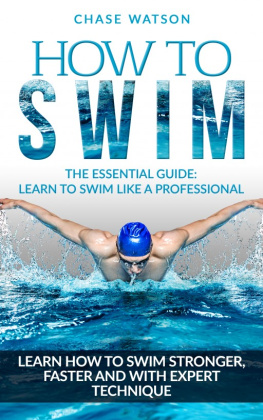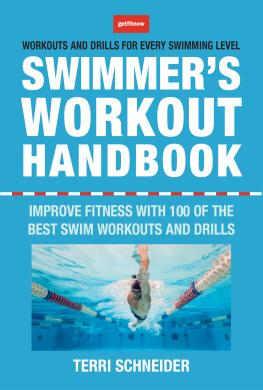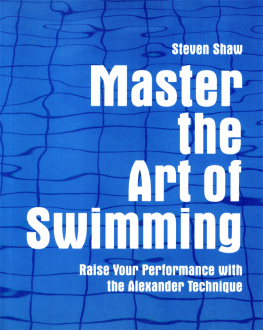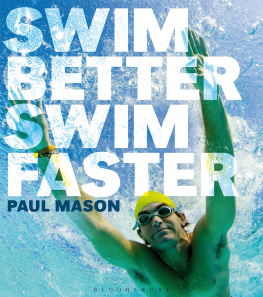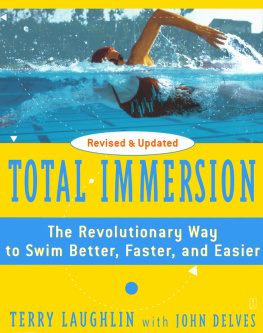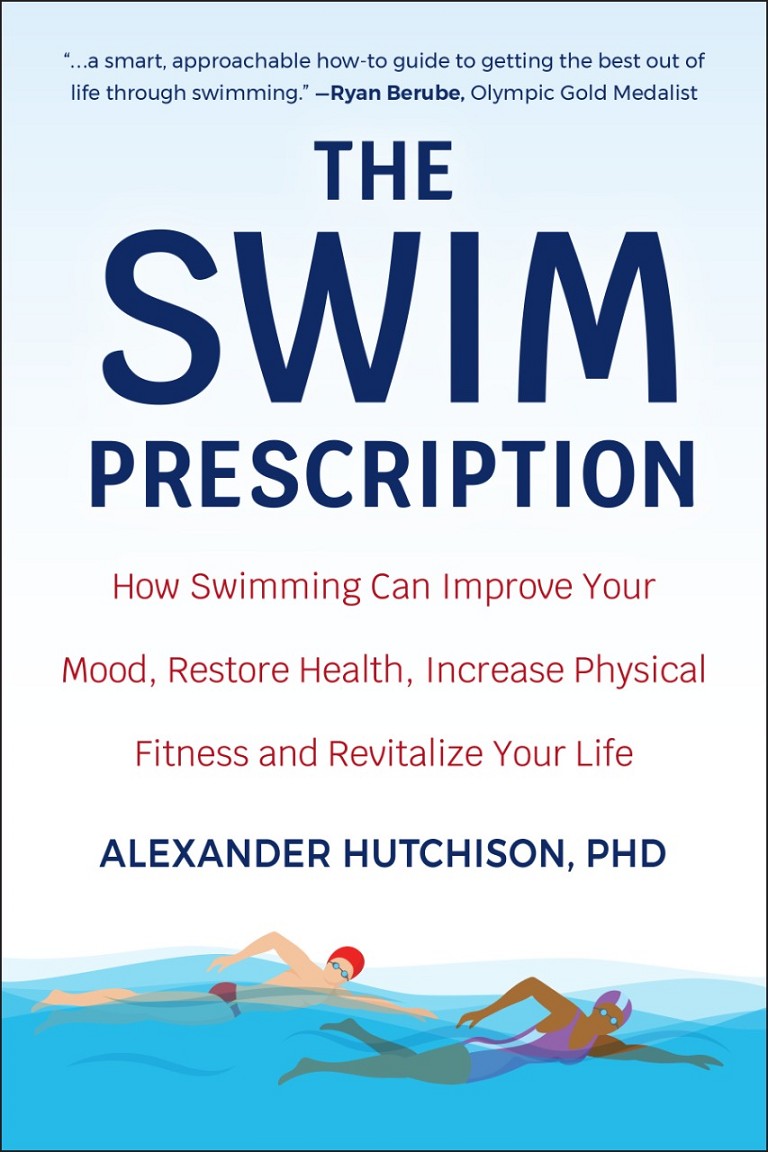Contents | 1. | | 2. | | 3. | | 4. | | 5. | | 6. | | 7. | | 8. | | 9. | | 10. | | 11. | | 12. | | 13. | | 14. | | 15. |
Hatherleigh Press is committed to preserving and protecting the natural resources of the earth. Environmentally responsible and sustainable practices are embraced within the companys mission statement. Visit us at www.hatherleighpress.com and register online for free offers, discounts, special events, and more. THE SWIM PRESCRIPTION
Text copyright 2022 Alexander Hutchison, PhD All rights reserved. No part of this book may be reproduced, stored in a retrieval system, or transmitted, in any form or by any means, electronic or otherwise, without written permission from the Publisher. Library of Congress Cataloging-in-Publication Data is available upon request.
ISBN 978-1-57826-926-6 All Hatherleigh Press titles are available for bulk purchase, special promotions, and premiums. For information about reselling and special purchase opportunities, please call 1-800-528-2550 and ask for the Special Sales Manager. Cover and Interior Design by Carolyn Kasper Your health starts here! Workouts, nutrition, motivation, community... everything you need to build a better body from the inside out! Visit us at www.getfitnow.com for videos, workouts, nutrition, recipes, community tips, and more! 10 9 8 7 6 5 4 3 2 1 Printed in the United States
For Charles van der Horst Dr. Charlie THE
SWIM
PRESCRIPTION Table of Contents References Chapter 1 Roels, B., et al., Specificity of VO2MAX and the ventilatory threshold in free swimming and cycle ergometry: comparison between triathletes and swimmers. Br J Sports Med, 2005. 39(12): p. 965-8. Holmer, I., Oxygen uptake during swimming in man. J Appl Physiol, 1972. 33(4): p. 502-9. Laurent, M., et al., Training-induced increase in nitric oxide metabolites in chronic heart failure and coronary artery disease: an extra benefit of water-based exercises? Eur J Cardiovasc Prev Rehabil, 2009. 16(2): p. 215-21. Chase, N.L.S., Xuemei; and Blair, Steven N., Swimming and All-Cause Mortality Risk Compared With Running, Walking, and Sedentary Habits in Men. International Journal of Aquatic Research and Education, 2008. 2(3). Chapter 2 Mehrotra, P.K., et al., Pulmonary functions in Indian sportsmen playing different sports. Indian J Physiol Pharmacol, 1998. 42(3): p. 412-6. Santos, M.L., et al., Maximal respiratory pressures in healthy boys who practice swimming or indoor soccer and in healthy sedentary boys. Physiother Theory Pract, 2012. 28(1): p. 26-31. Kate, N.N., et al., The Effect Of Short, Intermediate And Long Duration Of Swimming On Pulmonary Function Tests. Journal of Pharmacy and Biological Sciences, 2012. 4(3): p. 18-20. Eriksson, B.O., et al., Long-term effect of previous swimtraining in girls. A 10-year follow-up of the girl swimmers. Acta Paediatr Scand, 1978. 67(3): p. 285-92. Lomax, M., Airway dysfunction in elite swimmers: prevalence, impact, and challenges. Open Access J Sports Med, 2016. 7: p. 55-63. Matsumoto, I., et al., Effects of swimming training on aerobic capacity and exercise induced bronchoconstriction in children with bronchial asthma. Thorax, 1999. 54(3): p. 196-201. Varray, A.L., et al., Individualized aerobic and high intensity training for asthmatic children in an exercise readaptation program. Is training always helpful for better adaptation to exercise? Chest, 1991. 99(3): p. 579-86. Varray, A.L., J.G. Mercier, and C.G. Prefaut, Individualized training reduces excessive exercise hyperventilation in asthmatics. Int J Rehabil Res, 1995. 18(4): p. 297-312. Huang, S.W., et al., The effect of swimming in asthmatic children participants in a swimming program in the city of Baltimore. J Asthma, 1989. 26(2): p. 117-21. McNamara, R.J., et al., Water-based exercise in COPD with physical comorbidities: a randomised controlled trial. Eur Respir J, 2013. 41(6): p. 1284-91. Edlund, L.D., et al., Effects of a swimming program on children with cystic fibrosis. Am J Dis Child, 1986. 140(1): p. 80-3. Chapter 3 Downey, C., M. Kelly, and J.F. Quinlan, Changing trends in the mortality rate at 1-year post hip fracturea systematic review. World J Orthop, 2019. 10(3): p. 166-175. Bellew, J.W. and L. Gehrig, A comparison of bone mineral density in adolescent female swimmers, soccer players, and weight lifters. Pediatr Phys Ther, 2006. 18(1): p. 19-22. Kanis, J.A., Assessment of fracture risk and its application to screening for postmenopausal osteoporosis: synopsis of a WHO report. WHO Study Group. Osteoporos Int, 1994. 4(6): p. 368-81. Charles, H.K., Chen, M.H., Spisz, T.S., Beck, T.J., Feldmesser, H.S., Magee, T.C., and B.P. Huang, AMPDXA for Precision Bone Loss Measurements on Earth and in Space. Johns Hopkins APL Tech. Dig, 2004. 25(3): p. 187-201. Magkos, F., Yannakoulia, M., Kavouras, S.A., and L.S. Sidossis, The Type and Intensity of Exercise Have Independent and Additive Effects on Bone Mineral Density. Int J Sports Med, 2007. 28: p. 773-779. Theocharidis, A., McKinlay, B.J., Vlachopolous, D., Josse, A.R., Falk, B., and P. Klentrou. Effects of post exercise protein supplementation on markers of bone turnover in adolescent swimmers. J. Int. Soc. Sports Nutr, 2020. 17(20): p. 1-11. Chapter 4 Fleck, S.J., Body composition of elite American athletes. Am J Sports Med, 1983. 11(6): p. 398-403. Flynn, M.G., et al., Fat storage in athletes: metabolic and hormonal responses to swimming and running. Int J Sports Med, 1990. 11(6): p. 433-40. Deligiannis, A., et al., Plasma TSH, T3, T4 and cortisol responses to swimming at varying water temperatures. Br J Sports Med, 1993. 27(4): p. 247-50. White, L.J.D., R. H.; Holland, E.; McCoy, S. C.; Ferguson, M. A., Increased Caloric Intake Soon After Exercise in Cold Water. International Journal of Sport Nutrition and Exercise Metabolism, 2005. 14: p. 38-47. Horner, K.M., N.M. Byrne, and N.A. King, Reproducibility of subjective appetite ratings and ad libitum test meal energy intake in overweight and obese males. Appetite, 2014. 81: p. 116-22. King, J.A., et al., Individual Variation in Hunger, Energy Intake, and Ghrelin Responses to Acute Exercise. Med Sci Sports Exerc, 2017. 49(6): p. 1219-1228. Thackray, A.E., et al., An acute bout of swimming increases post-exercise energy intake in young healthy men and women. Appetite, 2020. 154: p. 104785. Chapter 5 Kargarfard, M., et al., Effect of aquatic exercise training on fatigue and health-related quality of life in patients with multiple sclerosis. Arch Phys Med Rehabil, 2012. 93(10): p. 1701-8. Castro-Sanchez, A.M., et al., Hydrotherapy for the treatment of pain in people with multiple sclerosis: a randomized controlled trial. Evid Based Complement Alternat Med, 2012. 2012: p. 473963. Volpe, D., et al., Comparing the effects of hydrotherapy and land-based therapy on balance in patients with Parkinsons disease: a randomized controlled pilot study. | Next page

